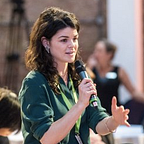What improvisation taught me about ideation
Over Christmas I was reading Tina Fey’s book BossyPants. It’s an amusing look at her life and work, but one part really stuck out for me; reading her ‘how to’ guide for improv comedy was like reading a ‘how to’ guide to ideation.
The process of developing an idea from scratch is one that many have tried and one that we, at Entrepreneur First, know intimately having helped 250 founders start companies from scratch, before they have a team or a fixed idea. It’s not easy. Harder still when you are developing an idea alongside a nascent working relationship with a potential co-founder.
This is where the rules of improvisation and ideation collide.
When you are in an improv scene, you are not coming up with ideas in a vacuum, alone, you’re working alongside and feeding off other comedians. Other people can be seen as an added complication, but Fey adeptly shows how the other person is often core to making the improv scene work.
Tina Fey’s rules for improvisation (with adaptations for ideation)
First rule — “Agree, say YES”
In improv, by agreeing to what your colleague suggests, you have started a scene. It allows both of you, together, to explore what you might be creating.
This is one of the most important lessons I have learnt about ideation. Those who are negative, who are good at critiquing ideas, don’t form teams. It’s the equivalent of, as Fey explains, ““Freeze, I have a gun,” and you say, “That’s not a gun. It’s your finger. You’re pointing your finger at me.” It kills the moment and suppresses creativity.
It’s easier to provide an insightful critique of an idea (because they are all flawed at inception) than it is to see the possibility and potential. It’s hard to work out how to build on and contribute to the idea. But that’s the most valuable thing you can do.
Fey says the rule of agreement means you “respect what your partner has created” and the effort it has taken to come up with the initial idea. Nobody is expecting, or wants, a fully thought through idea at this stage as this limits the future creative potential. This is true of both improv and ideation.
Second rule — “Not only say yes, but YES, AND”
Once you have agreed, you have started a scene. And then you need to add to it. You start contributing and building the scene together.
Comedian 1: “I can’t believe it’s so hot in here”
Comedian 2: “Yes, this can’t be good for the wax figures!”
This works better than simply agreeing that it’s hot in there. As Fey says, “It’s your responsibility to contribute. Always make sure you’re adding something to the discussion.”
The exciting bit about this is that by having more than one person contributing to the creation of the scene, the scene can go in directions that the initiator hadn’t imagined. The same is true in early stage startups. Many of our strongest teams and ideas have been created through a combination of unusual ideas or skills. For example, Magic Pony Technology created a new approach to video compression by combining machine learning and computer vision research. The founders built on each other’s experience and skills to create something unique that neither could have created alone.
Fey notes that “in improv there are no mistakes, only happy accidents. And many of the world’s great discoveries have been by accident.” This is of course true for ideation and startups. As Peter Thiel says “the best ideas often sound like bad ideas”.
Third rule — “Make statements”
Asking questions and rigorously critiquing an idea can be a fruitful way to help someone develop and progress their idea. But in the early stages of ideation, this can be destructive and demoralising.
“By asking questions all the time, I am creating pressure for you to make up all the answers. Whatever the problem, be part of the solution. Don’t just sit around raising questions and pointing out obstacles.” Fey says.
This is a common issue that we see when teams are ideating. By one founder creating an idea, the other is keen to then dig in and ask as many questions as possible, expecting the other to have the solution. It’s easy to forget that the strongest solution will be the one that is created together.
No magic bullet
Ideation is hard and often individuals want to either ideate alone, or critique those who are ideating — which makes it even harder. Ideating collaboratively, supporting and contributing at every stage, can lead to unexpected and valuable innovation. It is also likely to form stronger bonds and partnerships for potential co-founding relationships.
